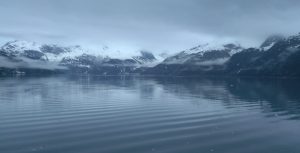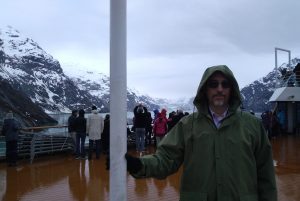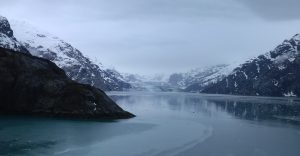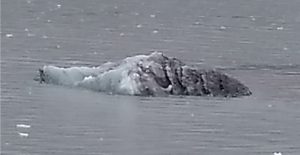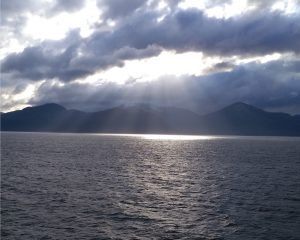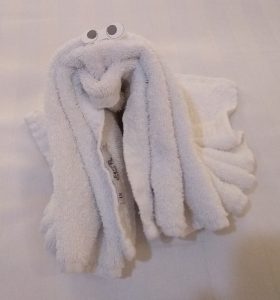I now resume the exciting, and largely factual, adventures of an intrepid foursome on their cruise to Alaska. I’ve changed many names to protect guilty and innocent alike. I traveled with my wife, Jean, and another couple, Brenda and Mike Knyght.
Day 8 dawned with MS Hellandam underway. At 6:56 am, we steamed on course 122° at a speed of 21.5 knots, crossing latitude 55°30’N. During the night, we’d weaved among various islands on our route to Ketchikan. Outside, no rain fell from the overcast sky, and winds blew 46°F air from the west at 8 knots. Since leaving Vancouver, we’d traveled 1,413 nautical miles.
I see I’ve neglected to give you my impressions of the Hellandam’s crew. The senior officers were mostly Dutch or English, but the ones with whom we interacted were from many other countries. Our server in the dining room—Rafid—was from Indonesia, and was unfailingly polite and prompt, and a bit of a jokester. Our room steward—Awang—always called us by name and took meticulous care of our room. Without exception, every one of the 604-person crew we met was gracious, helpful, friendly, and professional.
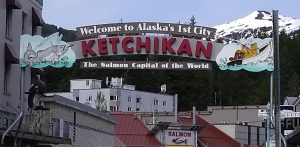
While waiting for breakfast to open in the Main Dining Room, Jean and I relaxed in the comfortable chairs of the Exploration Lounge. Gazing out the window, she spotted a whale. I said it was just a floating log…until it spouted. She kindly refrained from telling everyone this story, including the nice couple from Canada with whom we ate breakfast. Over a meal of Dungeness Crab Benedict, I watched the ship pull into the town of Ketchikan.
The four of us ate a quick and early lunch, since our shore excursion was to start just before noon. We disembarked and entered Ketchikan. If you’ve detected a pattern from previous blog entries, this town also lay at the base of giant mountains and contained a main street catering to tourists, crowded with gift shops, jewelry shops, a Christmas gift store, and seafood restaurants.
Ketchikan prides itself on being the rainiest city in the country, but we neither felt nor saw a single drop all day. That was odd, considering it had rained a little in every other port we visited.
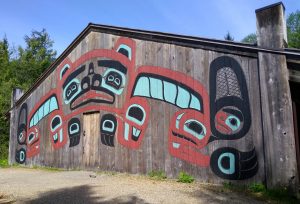
We boarded a bus driven by Mattie, who also served as our tour guide to introduce us to the native Tlingit village in nearby Saxman. There we learned more about the Tlingit natives, their customs, language, and entertainment. If you go there, be aware that Wasahee’atee means ‘How are you?’ and Kla’ek-wahsah means ‘I am fine.’ Finally, Gunalcheesh means ‘thank you.’

We saw many totem poles, and Tlingit guides welcomed us into the Beaver Clan Lodge where we enjoyed their dances and songs. We toured their totem pole carving workshop where natives explained the construction and meaning of these markers.
Then a strange thing happened.
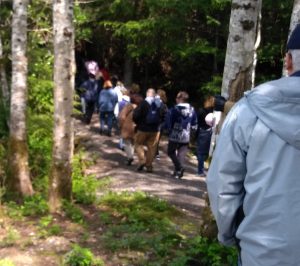
Our Tlingit guides led us on a “nature walk” along a path through a short stretch of woods. Cedar and pine predominated here, and we walked on uneven and rocky ground. A wave of unease and fear swept over me at one point, as if someone were watching me, but not one of the others on our tour. I gazed in the direction from where the eeriness emanated. In the shadow of a tree, just thirty yards away, stood a giant, hairy animal, a man-shaped thing. It towered some twelve feet high, and its hair blended with the browns and blacks of wood and earth.
The Sasquatch and I stared at each other for an eternal instant. I reached for my cellphone to take the photo of a lifetime, but the creature vanished. I asked if others in my group had seen anything unusual in that direction, but nobody had. At least, nobody admitted it. I’d had so many experiences on this cruise that I couldn’t explain or prove, and now I must add a Big Foot sighting to that list.
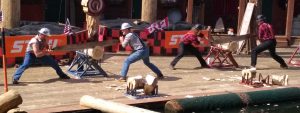
Our bus driver and tour guide then drove us back to Ketchikan where we watched the Great Alaskan Lumberjack Show. Four talented lumberjacks demonstrated great skill, strength, and humor in entertaining the crowd while showing common lumberjack roles and tasks.
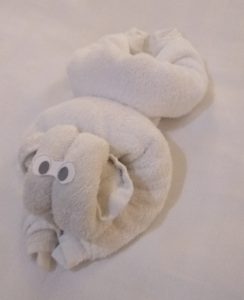
We returned to the ship, and it pulled away from the wharf at 6:00 pm to begin its return trip to Vancouver. The four of us ate a formal dinner in the Main Dining Room (mine was Kingfish), and we once again played the ‘For Sale’ card game in the quiet library called the Explorer’s Lounge.
Yet another towel origami creation awaited us on our cabin bed, courtesy of our multi-talented room steward. Although this day completed the port-touring opportunities on the cruise, I suspected further adventures awaited—
Poseidon’s Scribe

